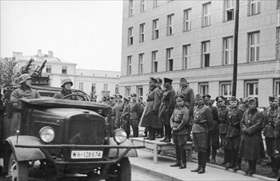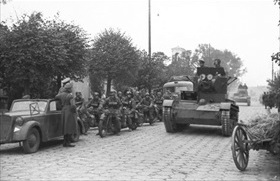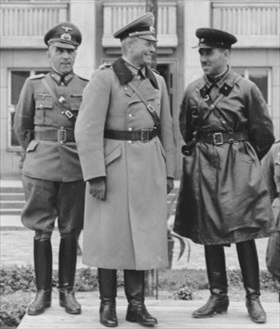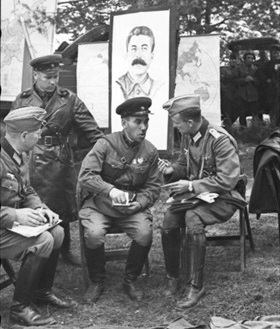NAZIS, SOVIETS DIVIDE POLAND
Brest-Litovsk, Occupied Eastern Poland · September 19, 1939
Adolf Hitler’s armies stormed over Poland’s border on September 1, 1939, in what became known as the first blitzkrieg—“lightning war.” Soviet dictator Joseph Stalin hastened to claim his share of the spoils under the terms of a secret protocol in the Molotov-Ribbentrop Pact signed in Moscow the month before, sending his forces into eastern Poland, where on this date in 1939 they met the advancing Germans at Brest-Litovsk on the River Bug (effectively the demarcation between the two occupation armies). On September 22, as German troops withdrew westward out of the Soviet “sphere of influence” in Poland, the two invaders celebrated a victory parade in Brest (in today’s Belarus). By month’s end, all Poland was under one tyranny or the other. Despite their easy victory, the Germans lost 13,000 killed and over 27,000 wounded. The Soviets lost less than a thousand because most combat was over by the time they invaded Poland on September 17. Polish casualties were high: 70,000 killed, 133,000 wounded. Over 900,000 Poles became prisoners of war: nearly 700,000 in German hands, 217,000 in Soviet hands. After Germany’s invasion of Soviet Union in June 1941 (Operation Barbarossa), between 3.3 and 3.5 million Soviet POWs were targeted for destruction by Nazi policies of neglect, abuse, malnutrition, and murder, mostly by shooting and gassing. No less than 200,000 Soviet prisoners died during forced labor, down from a peak of 631,000 in the summer of 1944. By 1944 Poland was the site of 9 out of 40 Nazi death camps, whose inmates included Polish civilians, POWs, European Jews (overwhelmingly), Roma (Gypsies), and political prisoners. Not until the summer of 1944, when the advancing Red Army overran the abandoned camp at Majdanek on the outskirts of Lublin, Poland, where 79,000 people died (59,000 of them Polish Jews) did the true extent of the Nazis’ genocidal policies become clear. Six months later, on January 27, 1945, the Soviets liberated Auschwitz-Birkenau, the largest German labor and death camp where at least 1.3 million died—around 90 percent of them Jews but also 15,000 Soviet prisoners at Auschwitz and thousands more at Birkenau. Ovens, mounds of corpses, and emaciated survivors testified in words, photographs, and motion pictures the depths of Nazi crimes against so-called Untermenschen (subhumans).
[amazon_carousel widget_type=”ASINList” width=”600″ height=”200″ title=”Recommended Reading” market_place=”US” shuffle_products=”False” show_border=”False” asin=”1841764086,0700613927,1592989942,0785329633,148267114X,0321276345,0739104845,0393338878,0781813026,0811707245″ /]
German-Soviet Military Parade in Brest-Litovsk, Poland, on September 22, 1939, Marked City’s Handover to Red Army
 |  |
Left: German-Soviet military victory parade in Brest-Litovsk, Poland (today in Belarus) on September 22, 1939. Both invaders saw the propaganda value in holding the parade, which was meant to display the power of the newly formed “Soviet-Nazi alliance” to the whole world.
![]()
Right: Rolling Soviet tanks and German motorcyclists. The Soviet contribution to the joint victory parade was modest—a military band and a few battalions—because Red Army soldiers were tired after their protracted march to Brest.
 |  |
Left: Sharing the reviewing stand in Brest were (l–r) German General of the Infantry Mauritz von Wiktorin; Maj. General Heinz Guderian, commander of German panzer (armored) forces in Poland; and Brig. Semyon Moiseevich Krivoshein, commander of the Soviet tank battalion that took Brest.
![]()
Right: German and Soviet personnel share experiences amid Brest victory parade display material. After the parade the Germans withdrew to the western bank of the River Bug, and the Soviets took control of Brest, which lay on the eastern bank, as well as the rest of Eastern Poland (now Western Belarus and Western Ukraine).
German-Soviet Victory Parade, Brest-Litovsk, September 22, 1939 (No audio)
![]()

 History buffs, there is good news! The Daily Chronicles of World War II is now available as an ebook for $4.99 on Amazon.com. Containing a year’s worth of dated entries from this website, the ebook brings the story of this tumultuous era to life in a compelling, authoritative, and succinct manner. Featuring inventive navigation aids, the ebook enables readers to instantly move forward or backward by month and date to different dated entries. Simple and elegant! Click
History buffs, there is good news! The Daily Chronicles of World War II is now available as an ebook for $4.99 on Amazon.com. Containing a year’s worth of dated entries from this website, the ebook brings the story of this tumultuous era to life in a compelling, authoritative, and succinct manner. Featuring inventive navigation aids, the ebook enables readers to instantly move forward or backward by month and date to different dated entries. Simple and elegant! Click 











